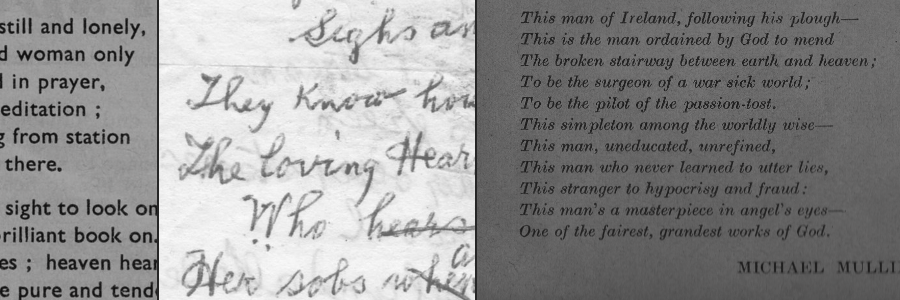O! the fun that is in Foremass at the stacking of the corn,
When autumn sun and wind have swept away the dews of morn;
Then Pat who has surveyed the stooks declares ‘tis time to start;
And Jamey currycombs the mare, and yokes her to the cart;
And Fracey goes to make a stile; and Biddy carries whins;
And little Tom for hook and fork and rake and tether runs.
And soon the rattling cart proclaims to whom it may concern
That onward to the haggard come the mare and load of corn.
Again the mare is trotted off towards the field of stooks;
While Biddy grasps her pitchfork – like a heroine she looks;
She aims the sheaves at Francy who is building on the stack:
Each hurrying to be finished ere another load comes back.’
‘Tis thus the pleasant work goes on, while song and laugh beguile
The busy hours away, and help to lighten heavy toil
O! it is exhilarating on a sunny autumn morn
In Foremass field or haggard at the stacking of the corn.
Michael Mullin
‘The Bard of Foremass’
Foremass Lower, Sixmilecross, Co. Tyrone.
Footnote by P.D. – This was a pre-vintage scene on the farm as the corn stacks were built in the haggard. The haggard was a small enclosed area beside the homestead where the hay and corn stacks were built. It had to be surrounded by a hedge and ditch to keep the stock away from it. The size of the farm could be judged by the size of the haggard.
This scene shows the great use made of all the plants growing on the farm, including the whins that Francy used to make a style. The style was the first layer of whins on the ground about a foot or two deep to keep the sheaves of oats from the dampness of the soil. There was generally a depth of stones on the ground and the style was built on this. As stacks were usually round in shape, these circles of stones may still be seen at some old farmsteads. Then rushes were used to thatch the stacks when they had settled down for a few weeks and the thatch kept the corn dry and safe for the whole winter. This was recycle, reuse in the greenest possible manner.
There are five people mentioned in this poem and as well the woman of the house was busy in her kitchen getting the meals ready for all the workers.


